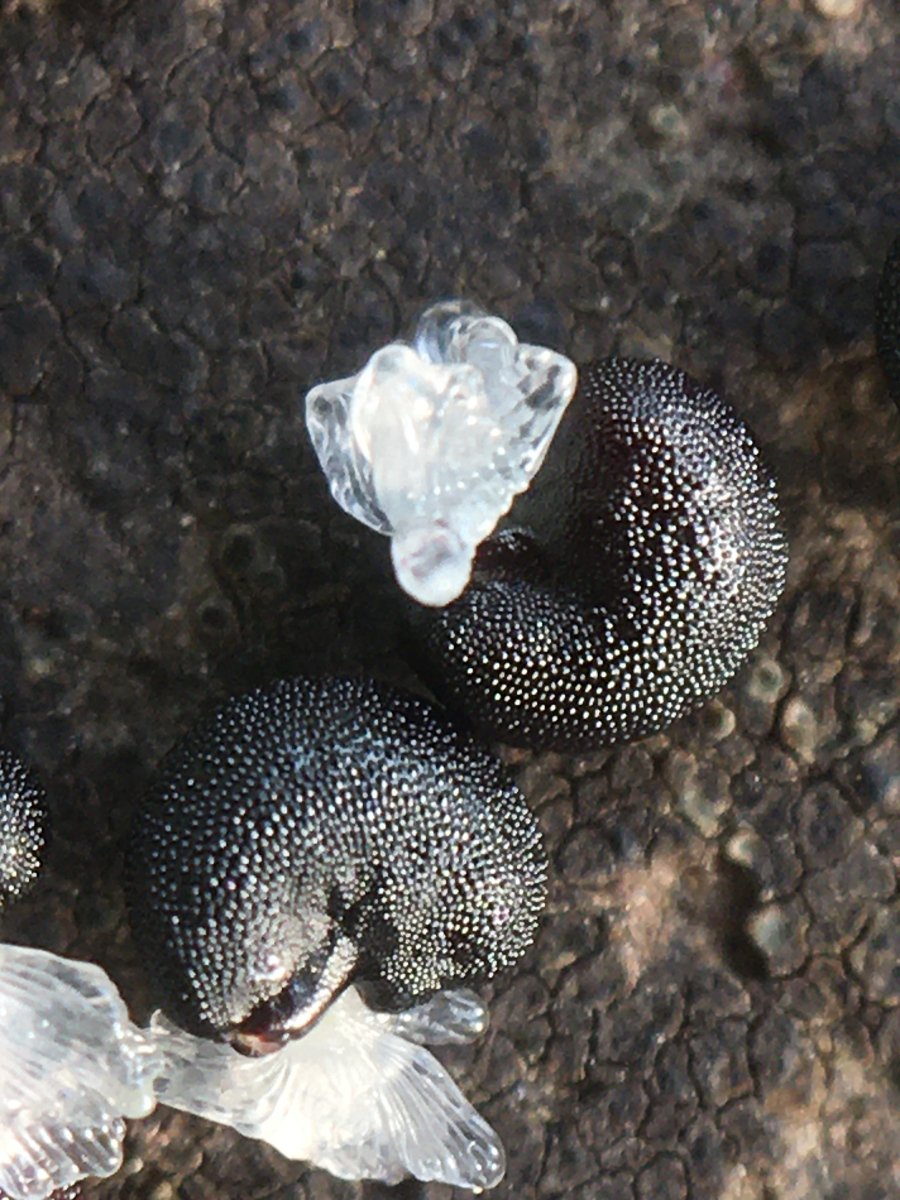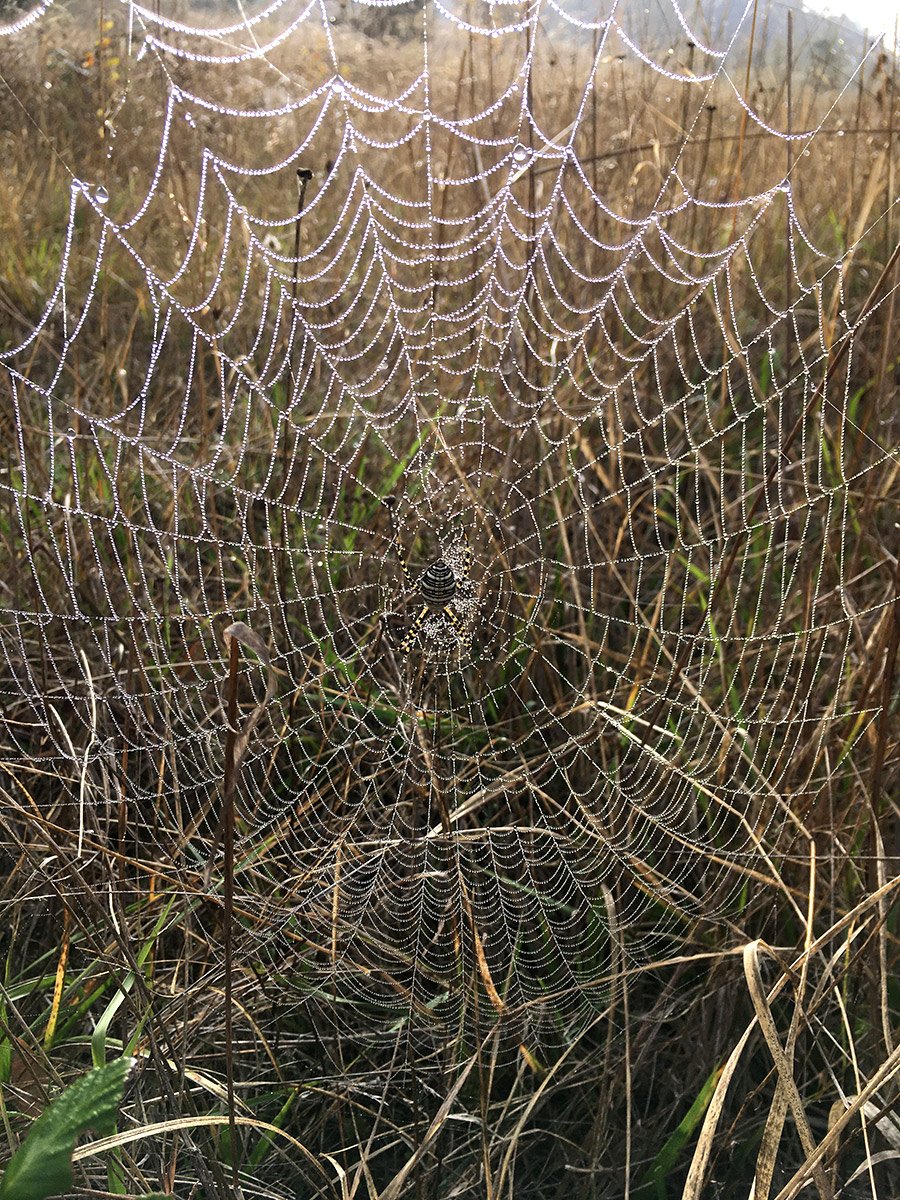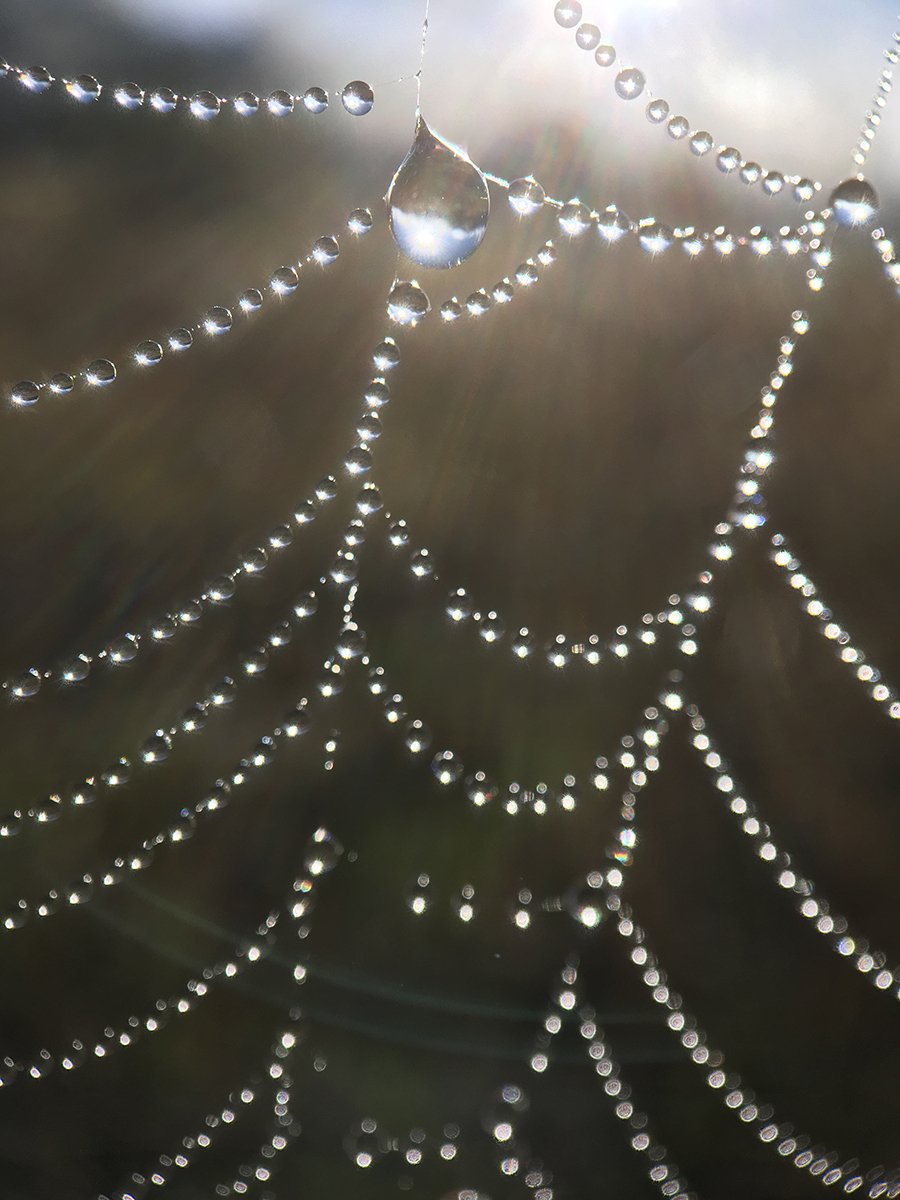Some flies stirred as I was walking down the path, and I looked over to see a dead snake. As I bent down to take a closer look, I saw that it was teeming with fly larvae inside its body. I was reminded of nature’s cycle of life. The purpose, strength, spirit, and medicine of so many unsung organisms that break down, transform, and recycle all of creation back into the stream of life are unbelievable.
River Jewelwing
This damselfly is truly a jewel with its iridescent blue body forged from stardust. The outer third of its wing is sooty—singed by the sun on its cosmic journey to earth. Its legs of wicker form a basket collecting and cradling our dreams. When we reawaken to our connection to nature, we will remember that we are all one.
Water Strider
The small, ephemeral stream that flows off the hillside next to the white oak pavilion is still softly trickling. As I follow the stream up the trail, there are places where the water is continuing to fill shallow pools.
In these pools, oval shadows ringed with light dance around the floor. Creating this celestial event are water striders! Where their feet contact the surface, it makes small dimples that are eclipsing the sun.
Miraculously, the surface tension of the water holds them up. They also have tiny hairs on their feet that trap air bubbles that help them stay buoyant and allow them to easily propel themselves along.
As distant images of the cosmos are streaming into our world from the James Webb telescope, these small pools remind me of the infinite universe contained within our planet earth.
Bleeding Heart Seed Pod
The bleeding hearts are forming their seed pods. The pods grow out of the corolla mouth and can be up to 2” long. The seeds are c-shaped, black, and have a pebbled, shiny surface. On one end is a white, oil-rich appendage known as an elaiosome, which is attractive to ants. They will collect the seed to eat the elaiosome and discard it, thus helping to disperse it.
There were 18 seeds in the pod I opened. I took them over to some ants and dropped the seeds in their path. They immediately investigated them, and within about 1 minute, all the seeds were carried off. It is amazing all the interesting ways seeds are spread.
As I looked at the seed more, the shape of it and the white elaiosome (rich in lipids and proteins) attached to the end reminded me of a small fortune cookie. I am sure the ants would agree that it was a fortuitous find.
Oak Treehopper Adults
The oak treehopper nymphs (see post on April 25) have been becoming adults over the past week or so. The diversity in form and color in the insect world is spectacular.
Blue Butterfly
A cool, quiet blue dye
delicately tints
the ephemeral life
that lives in all eternity
softening my eyes
and lightening the path
as I walk along
collecting memories.
Oak Treehoppers
Once I saw these amazing creatures congregating on the end of a small twig, I couldn’t remember why I originally walked over to this particular oak tree. I called my friend Don over to have a look, and he exclaimed, “They’re Oak Treehoppers!”
The nymphs of the oak treehopper look fairly ominous. They are boldly colored black, red, and white. In addition, they have spikes on the top of their body and red eyes. As they grow and develop, they will change colors and patterns. So, I’ll be going back to check on them regularly to see how they evolve and take some photos.
Next to the nymphs was an adult treehopper. I didn’t see this adult at first because she resembled a small tree bud. The adult treehoppers become well-camouflaged as they mature turning olive-brown with yellow dots. This is the female, and she will stay around to stand guard and protect her nymph colony as they grow.
Treehoppers drink the sap of the tree.
Caddisfly Larva
While looking in the small pools in the parking lot for frog eggs, I found a caddis fly larva. It was waddling around the pool searching for algae and other organic debris to eat. It makes the most beautiful, mobile home in the larval stage.
Depending on the environment, the larva gathers plant material, leaves, twigs, sand, small rock fragments, or other detritus, to build its temporary home. It cements it together with salivary silk forming a cylindrical tube. It lives inside this camouflaged, protective casing as it develops. When it is fully grown, it closes the tube ends and pupates inside. After this stage, it will cut open the case, rise to the surface of the water, undergo a final molt, and begin flying. As an adult, it usually only lives for a few weeks. During this time it focuses on reproduction. Most species do not eat as an adult, but a few species will visit flowers for nectar.
I have a photo of the adult somewhere in my album. When I find it, I will post it.
Rain Catcher
Spiders are amazing.
Pacific Ninebark Pithy Stems
Along the lily pond trail, the caretakers of the arboretum have trimmed back branches that grow into the pathway. I noticed that pretty much all the cut branches of the Pacific ninebark have small round holes in the center of the branch. I found a broken branch that showed a pithy center that I am sure is easy and delightful to bore out. As I looked further, I noticed that there were also holes in the cut branches of the snowberry bush and the Indian-plum.
I was reminded about something that I learned from the Xerces society. It is important to leave old flower stalks in your garden landscape. Many insects and spiders will seek refuge in the stalk’s hollow stem. They will also lay their eggs in the stems for protection through winter and hatch out in spring.
I also noticed that along some of the branches there were holes that I imagine were created by woodpeckers extracting whatever tasty morsels were inside.
Tree Crickets Mating
Over the last few days, I have observed the mating of tree crickets.
The male has translucent teardrop-shaped fore wings. The female has narrow fore wings that wrap closely around the back of her body.
I have mostly found the tree crickets on blackberry canes. Where I have found them mating, the female has laid her eggs in the cane. I see that she chews through the outer part of the stem and makes a small hole. I read that she puts excrement in the hole, lays her eggs and then coats them with a secretion. I broke part of the stem open at one of these egg-laying locations. Inside there were three slender, tubular eggs.
The Himalayan blackberries have excessively spread throughout the arboretum. It is a small consolation to know that tree crickets are using the blackberry canes as a place to lay their eggs for future generations.
I also found them mating and laying eggs on a small Oregon ash sapling, as you can see in the last two photos below.
Tree Cricket Singing
The melodious songs of tree crickets can be heard gently ringing through the air at the arboretum. The notes are crisp and refreshing. Its soothing rhythm flows softly across the landscape like a gentle stream. Its reverberant sound calms the spirit. It’s magical.
Woolly Aphids
As I walked along the lily pond trail, rays of sunlight shined through the trees illuminating miniature, fuzzy orbs floating up into the sky. A woolly aphid has a fibrous, white covering. It resembles a fluffy cotton ball as it flies through the air. It is mating season, and today was the perfect day to find a mate in the warm, fall sun.
At one point, I found myself in a whirlwind of songbirds darting about foraging on the aphids. It was a mixed flock of chickadees, ruby-crowned kinglets, golden-crowned kinglets, bushtits, Bewick’s wrens, and brown creepers. They were foraging from slightly off the ground all the way up into the tree canopy.
A runner coming down the trail saw me taking photos and stopped to silently watch all of the birds. Sometimes they were only a few feet away as they flitted through the underbrush gleaning aphids off the foliage or catching them out of the air. After about five minutes, he smiled and waved as he continued on his run.
Asian Lady Beetles
I found the adult beetle, its spiny larva and the pupae on the leaves of an oak limb that hangs over the bridge that is just behind the bathroom.
Many of the larvae are attaching to the leaves and entering into an immobile pupal stage. After a few days the adult beetle will emerge.
This beetle was introduced into the United States from Asia in the early 1900’s to control aphid populations and other soft-bodied insects.
Look closely and you can tell them apart from native ladybugs. Most asian beetles have a small white marking behind the head on a part called the pronotum. It is in the middle next to the colored forewings. This forms a prominent black "M" or "W" shape on the front of their bodies.
In the fall, the asian lady beetle will find protected places to congregate and overwinter. They often find their way inside people’s homes and other buildings.
Ancient Writings
I found a charred script that was exquisitely carved on a weathered, ashen canvas. They are ancient symbols communicating a message of the inscrutable depths and layers of life. It’s a reminder of the mystery of life and the vastness of all that is unknown and unknowable.
Moth - Alfalfa Semilooper
Out of the corner of my eye I saw some movement. I looked over just in time to watch this moth land on these dried leaves. I took out my camera, and when I went to take the photo, it took me a minute to find it again. Even after I took a couple a photos, my brain was still a little uncertain whether or not I had taken a picture of a dried leaf or a moth. To check, I slightly moved the vegetation that it was resting on. It slightly vibrated its wings to let me know it was there.
It truly feels impossible to put into words how incredible this moth’s texture and patten resembles dried leaves. It knows this and chooses the right place to land in order to camouflage itself. When I saw this one land, it was initially facing upward. Quickly after it lit upon the leaves, it shifted into this more downward facing position before it came to rest.
I used the following online publication to identify this moth: Lepidoptera of the Pacific Northwest: Caterpillars and Adults
Subterranean Termite
Last night I awoke to the sounds of rain drops pattering on the dusty window sill. I opened the window and the sweet smell of the earth breathing a sigh of relief came rushing inside. I wondered about what new life would awaken out of the slumber of late summer.
As I wandered around the arboretum, curtains of rain showers continued to sweep the day. During one of the intermissions, I heard the soft, whistling calls of a flock of cedar waxwings. When I walked out to an opening by the river, I saw them swooping out and back from a small tree. As I got closer I could see a fluttering of insects slowly taking flight off the ground.
Termites were emerging from a small hole and gathering together in a small cluster. Their wings were delicate and fresh with an opalescent luminance. As they took to the air, their flight was a white, wispy dance. As they silently floated skyward, it felt like a dream. They seemed more spirit than an animate creature of this world.
Praying Mantis
While walking along the south meadow, I saw a creature launch, fluttering and flapping out of the grass. As it propelled itself through the air, it reminded me of some whirligig invented in the initial days of flight exploration. I watched as it leap-frogged its way across the landscape. It was very noticeable while flying, but as soon as it landed, it quickly blended in with its surroundings.
Well-camouflaged to their environment, mantids are ambush predators. They wait motionless or slowly stalk their prey. This creature gets its name from holding its fore legs in a prayerful pose. These legs are armed with barbs that can snare an unsuspecting insect. They strike with lightning speed, and once in their grasp, their powerful mouthparts easily pierce through the armored exoskeleton. I’ve watched them munch and crunch a grasshopper effortlessly. I read that they are voracious eaters, even going so far as being cannibalistic! The female often devours the male after mating. I also read that as they emerge as tiny mantids in the spring, they will sometimes eat each other. It is easy to see why gardeners employ these amazing creatures to help keep other critters eating their garden in balance.
California Sister
I stood out in the main meadow just beyond the White Oak Pavilion and watched this butterfly as it flew in and out of the outer branches of the oak trees.
Although it has quite a bumpy, meandering flight pattern, it seems like it has a territory. There was a breeze swirling about and small, brown oak leaves were floating and tumbling through the air. Amusingly, if one of the leaves fluttered into the butterfly’s airspace, it would swoop over to it as if to warn the intruder. Even dragonflies would be paid a visit if they came into its domain.
I loved watching the flash of its bold orange and white markings. It is a fairly quick flyer and a little tricky to follow as it weaves through the landscape. It would only light somewhere for a few seconds, which made getting a photo pretty tricky. However, it occasionally paused on these overripe blackberries for a minute or so to eat. In my research I found that rotting fruit is part of their diet. So look for a patch of blackberries along the edge of the oak savanna. This is a good place to try and get a good look at them as they momentarily pause to eat. Good luck.
Black-and-yellow Argiope
Spiders are magical creatures. They have organs called spinnerets that produce silk. This amazing material is used very creatively in the world of spiders. The most obvious use is that it can be used to build webs like the circular construction of this orb-weaver. Their silk is also used for swathing prey that gets caught in the web and to make sacs to encase the spider eggs. In a process called ballooning or parachuting, some spiders will release silk that can be caught by the wind which allows them to float into the air. I read a National Geographic article that said ballooning spiders have been found more than two miles high and thousands of miles out at sea! Spider webs are strong, stretchy, sticky and very versatile. Many birds will collect them and use them in building their nests.
The spider in the photos is the female. The males are smaller with brownish legs and less yellow coloration on their abdomens. The male seeks out a female and plucks at her web during courting. After mating, the female fills a spherical sac with a tough, brown papery covering. She attaches it to one side of the web close to resting position, then dies. Eggs hatch in the autumn, young overwinter in the sac and then disperse in the spring.
References:
Milne, Lorus and Margery. National Audubon Society Field Guide to North American Insects & Spiders. New York, Knopf, 1996.
https://www.nationalgeographic.com/animals/article/spiderwebs-explained
































































